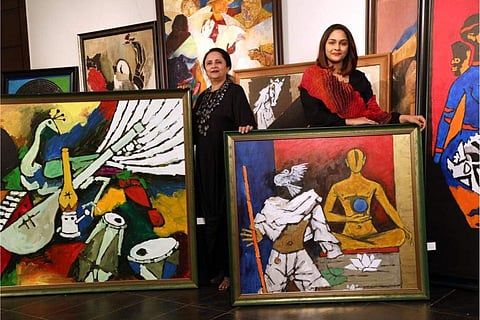
- LIFESTYLE
- FASHION
- FOOD
- ENTERTAINMENT
- EVENTS
- CULTURE
- VIDEOS
- WEB STORIES
- GALLERIES
- GADGETS
- CAR & BIKE
- SOCIETY
- TRAVEL
- NORTH EAST
- INDULGE CONNECT

The recently held art exhibition Titans of Time at Tao Art Gallery, Worli, Mumbai, features some iconic works from the repertoire of the enduring legacies of artists like Ram Kumar, F N Souza, J Swaminathan, M F Husain and Jogen Chowdhury. Curated by the mother-daughter duo Kalpana Shah and Sanjana Shah, the exhibition showcases paintings that are exceptional pieces of art documented and appreciated over the years. We speak to Sanjana who shares more about the masters’ show and more.
Tell us about the exhibition and the concept and idea behind it.
The idea for this show was to honour our Modernist history and its masters. The works are all interesting milestone pieces on their journey in unique ways, and we wanted to showcase how, despite the passage of time, the impact of the works remains as strong as ever hence the title Titans of Time. The curation features exceptional pieces documented and appreciated over the years! This show was an attempt to pay tribute to these intense moments of creation that are, in many ways, the foundation of Indian Art, paving the way forward by providing a culturally vital and relevant base. The history of our art is even more important today as we speed forward and look towards an incredibly innovative future. At Tao, I like to have a combination of exhibitions that not only focus on the trends for tomorrow in the Indian art world but also on the cultural context in which it all began. This show endeavoured to showcase our rich legacy of art!
Why did you exhibit these art pieces, and how do you relate to them?
From the enormous Ram Kumar landscape comprising four canvases to the rare self-portrait of Swami and the historical work by Husain inspired by the 1971 Bangladesh War - each work is iconic. Instead of generally showing works, I wanted to focus on a selective curation of engrossing narratives that differed from the usual works they created. The Husain work is starkly different from any he has made because of its dark, sombre tone, compared to his usually rich and colourful mythology depictions. Here you can see the personal elements in the work and the pain the artist has poured into it as an anti-war painter. Swaminathan's self-portrait is also an exciting glimpse into how the artist views himself, and his meditative space makes you connect with the artist on a very personal level. It was again rare for him to make, and the ability to engage with such unique works is fantastic!
Which is your favourite artwork and why?
The Souza 'Mutation' work is my favourite because it makes the viewer feel a mixture of emotions. It is like a contradictory set of emotions, dark humour and irony and craziness all combined into one. I find it very interesting, and each time I look at it, I am caught in a world of analysis and interpretations!
As you grew up around many iconic artists, can you share some unique streaks of the masters?
Being around so many amazing artists while growing up has been a privilege. I distinctly remember Husainji, Razaji and Bal Chabdaji because my mother, Kalpana Shah, was closest to them. I remember being shown around their studios, having dinners, and attending art events in India and abroad. The energy was great, and the vibrancy they brought to every conversation was beautiful to experience. Husainji, in particular, always had a poetic and philosophical way of looking at the world, even mundane things we barely notice. He always noticed the things we take for granted, but he would see them from a unique perspective only creative people have.
I remember my mother telling me once that while looking at a sunset, Husainji said, "Look at the sunrise on the other side". It was this very ability to engage with everything around them that made these masters exceptional. That era was much less complicated, with loyalty between artists, gallerists and curators. An unspoken agreement and a deep bond were the foundation for that. Contracts and agreements were rarely needed, and the synergy in putting up a show was dynamic and pure. The iconic first-anniversary show of Tao's in 2001 Ashtanayak was a group effort where Krishen Khanna did the writing, Husainji designed the catalogue, and Mom curated the show! To have this kind of energy while working together was magical.
Any advice you can give to a budding artist?
Create art for the right reasons for you. It is very subjective and personal and has to come from a space of pure creativity rather than be motivated by external factors or expectations. Art is supposed to be an instinct and organic rather than forced with a set outcome in mind. The minute you dilute that, the art will come across as inauthentic and hard to relate to. However, that is precisely what the masters did - they stayed true to their intuition, which is why the works grew to become iconic and loved!
How did you choose and curate the artworks?
We had a selection of works from our private collectors, and I picked the ones I felt would have the most impact with their unique history and cultural/artistic journey relevance. The personal elements of each work and how it marked a visible progression in the artist's process intrigued me and motivated me to put these works together. I like the variety of moods they all present when they come together!